Holly Thompson's Blog, page 40
December 29, 2010
Mochi Making
Yesterday a package arrived from friends: a boxful of handmade mochi with wishes for happiness in the new year. The varieties of mochi were beautifully labeled: yuzu, potato, millet, wasabi, and plain. We couldn't resist grilling some, wrapped in nori and dipped in soy sauce, for lunch today, but we will sure to save enough for our ozoni soup on New Year's Day.
 Mochi package from a friendMochi is a traditional New Year's food in Japan, and in previous years we've joined these friends at their mochi tsuki (mochi pounding) party, an all-day affair with several families working together to pound and shape the various types of mochi.
Mochi package from a friendMochi is a traditional New Year's food in Japan, and in previous years we've joined these friends at their mochi tsuki (mochi pounding) party, an all-day affair with several families working together to pound and shape the various types of mochi.
First, mochi rice is steamed...
 Mochi rice steamingthen pounded in a stone usu with a wooden kine mallet...
Mochi rice steamingthen pounded in a stone usu with a wooden kine mallet...
 Pounding the mochiuntil the rice becomes glutinous mochi.
Pounding the mochiuntil the rice becomes glutinous mochi.
 Pulling sections of mochi
Pulling sections of mochi
The half-spheres for kagami mochi decorations are formed... Forming a kagami mochi baseenough for several families to use as decorations in their homes.
Forming a kagami mochi baseenough for several families to use as decorations in their homes.
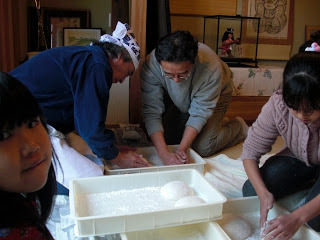
Next, other varieties are made--different flavors and different shapes
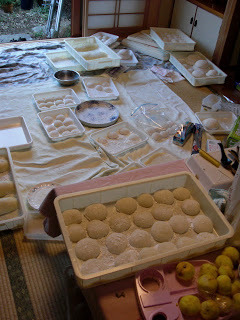 and a mochi feast is enjoyed while the pounding and shaping continue...
and a mochi feast is enjoyed while the pounding and shaping continue...
 Bowls of mochi in azuki, with kinako, with yuzu, and in soupEveryone goes home from these mochi making parties with mochi galore for the New Year celebrations...and enough to freeze for later. Though we missed the party this year, we will enjoy the tasty results of our friends' mochi pounding efforts.
Bowls of mochi in azuki, with kinako, with yuzu, and in soupEveryone goes home from these mochi making parties with mochi galore for the New Year celebrations...and enough to freeze for later. Though we missed the party this year, we will enjoy the tasty results of our friends' mochi pounding efforts.

 Mochi package from a friendMochi is a traditional New Year's food in Japan, and in previous years we've joined these friends at their mochi tsuki (mochi pounding) party, an all-day affair with several families working together to pound and shape the various types of mochi.
Mochi package from a friendMochi is a traditional New Year's food in Japan, and in previous years we've joined these friends at their mochi tsuki (mochi pounding) party, an all-day affair with several families working together to pound and shape the various types of mochi.First, mochi rice is steamed...
 Mochi rice steamingthen pounded in a stone usu with a wooden kine mallet...
Mochi rice steamingthen pounded in a stone usu with a wooden kine mallet... Pounding the mochiuntil the rice becomes glutinous mochi.
Pounding the mochiuntil the rice becomes glutinous mochi. Pulling sections of mochi
Pulling sections of mochiThe half-spheres for kagami mochi decorations are formed...
 Forming a kagami mochi baseenough for several families to use as decorations in their homes.
Forming a kagami mochi baseenough for several families to use as decorations in their homes.
Next, other varieties are made--different flavors and different shapes
 and a mochi feast is enjoyed while the pounding and shaping continue...
and a mochi feast is enjoyed while the pounding and shaping continue... Bowls of mochi in azuki, with kinako, with yuzu, and in soupEveryone goes home from these mochi making parties with mochi galore for the New Year celebrations...and enough to freeze for later. Though we missed the party this year, we will enjoy the tasty results of our friends' mochi pounding efforts.
Bowls of mochi in azuki, with kinako, with yuzu, and in soupEveryone goes home from these mochi making parties with mochi galore for the New Year celebrations...and enough to freeze for later. Though we missed the party this year, we will enjoy the tasty results of our friends' mochi pounding efforts.
Published on December 29, 2010 22:26
December 25, 2010
Yuzu Citrus and the Solstice
The sun now appears as if it has been misplaced, setting far south of Mt. Fuji over the Izu hills on the stretch of horizon we watch. Fewer surfers ride the waves.
 Sunrise is not until nearly 7 am which means it is pitch black when the local temple bells ring at 6 am. Laundry hung on the balcony has only a few short hours of sunlight to dry. Sunset is just after 4:30 pm. making for long, cold evenings.
Sunrise is not until nearly 7 am which means it is pitch black when the local temple bells ring at 6 am. Laundry hung on the balcony has only a few short hours of sunlight to dry. Sunset is just after 4:30 pm. making for long, cold evenings.
But yuzu fruit is in abundance this time of year. A yuzu tastes like a heavenly cross between a lime, grapefruit and mikan. Yuzu originated in China and have traveled east and west across the globe. Here in Japan, yuzu rind is used for marmalades and for zest in cooking, the juice is made into a syrup, and syrup and rind are combined to make sweet citrus tea. Soaking in a bath of yuzu at the time of the winter solstice (toji in Japanese) is supposed to ensure health in the coming year.
Below, a bowlful of yuzu harvested from a Kamakura garden.
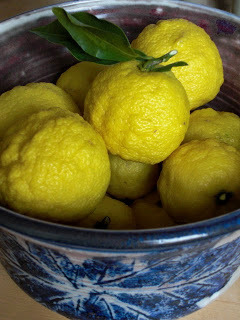 And here is a photo from the Daily Yomiuri of bathers in a Nikko hotspring filled with 2,011 yuzu.
And here is a photo from the Daily Yomiuri of bathers in a Nikko hotspring filled with 2,011 yuzu.
Wishing you good health in the coming year!
 Sunrise is not until nearly 7 am which means it is pitch black when the local temple bells ring at 6 am. Laundry hung on the balcony has only a few short hours of sunlight to dry. Sunset is just after 4:30 pm. making for long, cold evenings.
Sunrise is not until nearly 7 am which means it is pitch black when the local temple bells ring at 6 am. Laundry hung on the balcony has only a few short hours of sunlight to dry. Sunset is just after 4:30 pm. making for long, cold evenings.But yuzu fruit is in abundance this time of year. A yuzu tastes like a heavenly cross between a lime, grapefruit and mikan. Yuzu originated in China and have traveled east and west across the globe. Here in Japan, yuzu rind is used for marmalades and for zest in cooking, the juice is made into a syrup, and syrup and rind are combined to make sweet citrus tea. Soaking in a bath of yuzu at the time of the winter solstice (toji in Japanese) is supposed to ensure health in the coming year.
Below, a bowlful of yuzu harvested from a Kamakura garden.
 And here is a photo from the Daily Yomiuri of bathers in a Nikko hotspring filled with 2,011 yuzu.
And here is a photo from the Daily Yomiuri of bathers in a Nikko hotspring filled with 2,011 yuzu.Wishing you good health in the coming year!
Published on December 25, 2010 17:26
December 13, 2010
Book Charities--how do you support literacy?
In the past few years I have made my own individual efforts to give books where needed...sending picture books to a library in Mongolia, donating to Room to Read's Local Language Publishing Program, and donating books to libraries and schools locally and when I travel.
There are many book charities worldwide that support literacy and reading, and Amanda Allen of the Children's Literature Program at Eastern Michigan University has put together an amazing list of these charities on her blog Playing by the Book. The list is organized into the following categories: International, U.K., Australia, U.S., Canada, Africa, India and Others.
This year my focus is on Cambodia and doing what I can to help increase literacy in that country. How about you?
There are many book charities worldwide that support literacy and reading, and Amanda Allen of the Children's Literature Program at Eastern Michigan University has put together an amazing list of these charities on her blog Playing by the Book. The list is organized into the following categories: International, U.K., Australia, U.S., Canada, Africa, India and Others.
This year my focus is on Cambodia and doing what I can to help increase literacy in that country. How about you?
Published on December 13, 2010 22:35
December 8, 2010
SCBWI Tokyo 2010 Illustrators Exhibition
Last night I attended the opening party of the SCBWI Tokyo Illustrators Exhibition at Galerie Malle in Ebisu, Tokyo. The title of the show is Every Picture Tells a Story and features children's book illustrators Sonja de Boer, Patrick Gannon, Michael Kloran, Naomi Kojima, Midori Mori, Daniel Schallau, Izumi Tanaka, Kiyo Tanaka and Yoko Yoshizawa. The exhibit was juried by U.K.-based illustrator John Shelley and Galerie Malle owner Shizuko Kikawa.
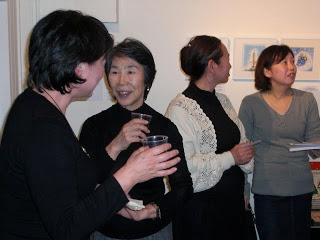 Galerie Malle owner Shizuko Kikawa (second from left) chats with the illustratorsIt was a great party complete with ukulele music--a professional jazz singer who happened by the show on her way home from her ukulele lessons.
Galerie Malle owner Shizuko Kikawa (second from left) chats with the illustratorsIt was a great party complete with ukulele music--a professional jazz singer who happened by the show on her way home from her ukulele lessons.
 Illustrator Yoko Yoshizawa speaking with Fukuinkan editor Shigeru Yoshida
Illustrator Yoko Yoshizawa speaking with Fukuinkan editor Shigeru Yoshida
 Illustrator Sonja de Boer and guests
Illustrator Sonja de Boer and guests
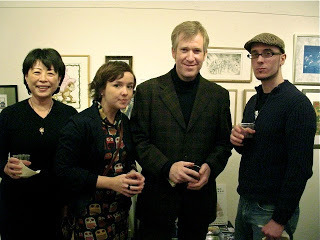 Illustrators Naomi Kojima, Sonja de Boer, Dan Schallau and Patrick Gannon
Illustrators Naomi Kojima, Sonja de Boer, Dan Schallau and Patrick Gannon
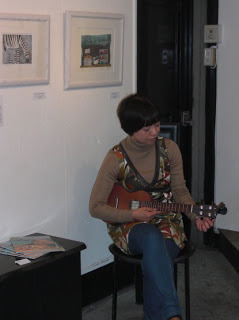 Ukulele player
Ukulele player
The show is up through Sunday, so stop by if you can. All of the art works are for sale. Holiday shopping anyone?

 Galerie Malle owner Shizuko Kikawa (second from left) chats with the illustratorsIt was a great party complete with ukulele music--a professional jazz singer who happened by the show on her way home from her ukulele lessons.
Galerie Malle owner Shizuko Kikawa (second from left) chats with the illustratorsIt was a great party complete with ukulele music--a professional jazz singer who happened by the show on her way home from her ukulele lessons.  Illustrator Yoko Yoshizawa speaking with Fukuinkan editor Shigeru Yoshida
Illustrator Yoko Yoshizawa speaking with Fukuinkan editor Shigeru Yoshida
 Illustrator Sonja de Boer and guests
Illustrator Sonja de Boer and guests
 Illustrators Naomi Kojima, Sonja de Boer, Dan Schallau and Patrick Gannon
Illustrators Naomi Kojima, Sonja de Boer, Dan Schallau and Patrick Gannon Ukulele player
Ukulele playerThe show is up through Sunday, so stop by if you can. All of the art works are for sale. Holiday shopping anyone?
Published on December 08, 2010 03:58
December 2, 2010
Leonard Marcus in Tokyo and Kamakura
Children's book historian, author and critic Leonard Marcus was in Japan for an event with the International Library of Children's Literature in Ueno, Tokyo, and coinciding with the publication of the Japanese edition of Dear Genius: The Letters of Ursula Nordstrom. SCBWI Tokyo was fortunate to schedule a presentation with Leonard on November 28, and afterward I was lucky to tag along as Leonard was taken to some Kamakura sites by Editorial Director Akiko Beppu of Kaisei-sha, the Japanese publisher of Dear Genius; author/illustrator Naomi Kojima who translated Dear Genius; and translator/critic Kari Haijima. It was a day spent immersed in book talk strolling about town amid peak foliage with breaks for tea and sweets and a home-cooked crab dinner--perfect!
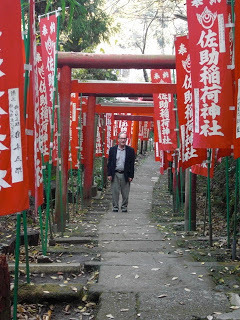 Leonard approaching Sasuke Inari Shrine
Leonard approaching Sasuke Inari Shrine
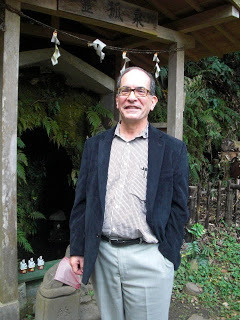 Leonard at Sasuke Inari Shrine
Leonard at Sasuke Inari Shrine
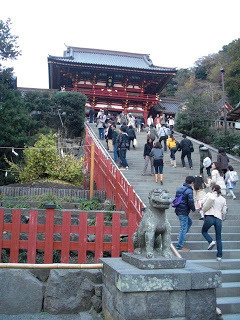 Hachiman Shrine with just a stump of the Hiding Tree; the ancient gingko that was toppled in a March storm
Hachiman Shrine with just a stump of the Hiding Tree; the ancient gingko that was toppled in a March storm
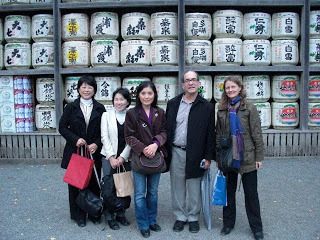 Naomi Kojima, Akiko Beppu, Kari Haijima, Leonard Marcus and me at Hachiman Shrine
Naomi Kojima, Akiko Beppu, Kari Haijima, Leonard Marcus and me at Hachiman Shrine
 Leonard approaching Sasuke Inari Shrine
Leonard approaching Sasuke Inari Shrine Leonard at Sasuke Inari Shrine
Leonard at Sasuke Inari Shrine
 Hachiman Shrine with just a stump of the Hiding Tree; the ancient gingko that was toppled in a March storm
Hachiman Shrine with just a stump of the Hiding Tree; the ancient gingko that was toppled in a March storm  Naomi Kojima, Akiko Beppu, Kari Haijima, Leonard Marcus and me at Hachiman Shrine
Naomi Kojima, Akiko Beppu, Kari Haijima, Leonard Marcus and me at Hachiman Shrine
Published on December 02, 2010 23:23
November 25, 2010
Mikan Harvest
As soon as the weather turns cool, I ache to be in the hills snipping mikan and dropping them into a shoulder basket, so yesterday I drove down to the Nishiura district in northwest Izu to visit the mikan growers I'd worked with for eighteen months as part of my research for Orchards (and two other book projects).
It had rained the night before, and the trees would be wet until mid-day, so I waited until well after sunrise to start my drive. The skies cleared as I headed west, and Mount Fuji showed a fresh, full snow cap.
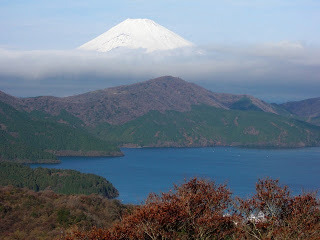 Mt. Fuji and Lake AshiIt had been a while since I'd visited the tiny village on Suruga Bay. As soon as I arrived the farmer drove me up into the groves, and we immediately sat down on some crates to chat. It was great to have the chance to catch up with the farmer and his wife, to hear about their children and grandchildren, to ask after people in the village and hear the local news.
Mt. Fuji and Lake AshiIt had been a while since I'd visited the tiny village on Suruga Bay. As soon as I arrived the farmer drove me up into the groves, and we immediately sat down on some crates to chat. It was great to have the chance to catch up with the farmer and his wife, to hear about their children and grandchildren, to ask after people in the village and hear the local news.
We worked in the family's largest orchard, harvesting aoshima mikan on a terraced hillside about 140 meters above sea level.
 Tools of the trade
Tools of the trade
Mikan are harvested with scissors, one by one. Workers snip the mikan from the tree with two snips--one to cut the fruit from the branch and another to cut the stem close to the rind--then drop the fruit into wicker baskets.
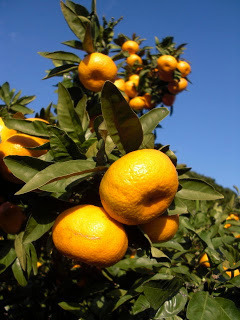 Ripe Aoshima mikanWhen the baskets are full, the mikan are poured into crates. The crates are taken off the mountain by truck or by monorack (miniature monorail).
Ripe Aoshima mikanWhen the baskets are full, the mikan are poured into crates. The crates are taken off the mountain by truck or by monorack (miniature monorail).
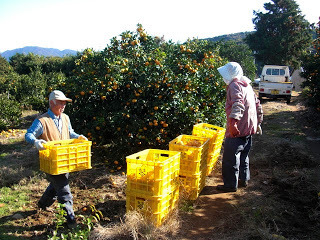 Bringing the full crates of mikan to the road to load onto the truck
Bringing the full crates of mikan to the road to load onto the truck
A cousin had just arrived to help the farmer and his wife with the harvest, which will continue nonstop through mid-January. The three of them will harvest terrace after terrace of mikan, day after day, as the weather turns from cool to bitter cold. I'm hoping I can get down there to help a few more times during this harvest season.
An unusual snowfall in April and the excessively hot summer had been tough on mikan, and when we broke for lunch and drove down into the village, here and there the farmer pointed out groves at lower altitudes that had failed due to the heat.
The mikan farmers in the village are all aging and, sadly, few of the younger villagers plan to carry on farming. Japan's farm villages are absolute treasures, but the future is uncertain for still-vibrant farm districts like Nishiura. I'm hopeful that some innovative cooperative farming solutions will enable a district like Nishiura to survive without sacrificing its unique character.
By the time we came down off the mountain in the late afternoon the sky was nearly dark. The family would then sort mikan for shipping in the driveway, probably for another hour, but I had to drive over the mountains back to Kamakura, so I said my good-byes.
But no one who visits a farm leaves empty handed...I left with large bags full of green peppers and spinach; an armload of two varieties of daikon; both fresh and dried shiitake; and a box full of my beloved mikan.
It had rained the night before, and the trees would be wet until mid-day, so I waited until well after sunrise to start my drive. The skies cleared as I headed west, and Mount Fuji showed a fresh, full snow cap.
 Mt. Fuji and Lake AshiIt had been a while since I'd visited the tiny village on Suruga Bay. As soon as I arrived the farmer drove me up into the groves, and we immediately sat down on some crates to chat. It was great to have the chance to catch up with the farmer and his wife, to hear about their children and grandchildren, to ask after people in the village and hear the local news.
Mt. Fuji and Lake AshiIt had been a while since I'd visited the tiny village on Suruga Bay. As soon as I arrived the farmer drove me up into the groves, and we immediately sat down on some crates to chat. It was great to have the chance to catch up with the farmer and his wife, to hear about their children and grandchildren, to ask after people in the village and hear the local news.We worked in the family's largest orchard, harvesting aoshima mikan on a terraced hillside about 140 meters above sea level.
 Tools of the trade
Tools of the tradeMikan are harvested with scissors, one by one. Workers snip the mikan from the tree with two snips--one to cut the fruit from the branch and another to cut the stem close to the rind--then drop the fruit into wicker baskets.
 Ripe Aoshima mikanWhen the baskets are full, the mikan are poured into crates. The crates are taken off the mountain by truck or by monorack (miniature monorail).
Ripe Aoshima mikanWhen the baskets are full, the mikan are poured into crates. The crates are taken off the mountain by truck or by monorack (miniature monorail). Bringing the full crates of mikan to the road to load onto the truck
Bringing the full crates of mikan to the road to load onto the truck A cousin had just arrived to help the farmer and his wife with the harvest, which will continue nonstop through mid-January. The three of them will harvest terrace after terrace of mikan, day after day, as the weather turns from cool to bitter cold. I'm hoping I can get down there to help a few more times during this harvest season.
An unusual snowfall in April and the excessively hot summer had been tough on mikan, and when we broke for lunch and drove down into the village, here and there the farmer pointed out groves at lower altitudes that had failed due to the heat.
The mikan farmers in the village are all aging and, sadly, few of the younger villagers plan to carry on farming. Japan's farm villages are absolute treasures, but the future is uncertain for still-vibrant farm districts like Nishiura. I'm hopeful that some innovative cooperative farming solutions will enable a district like Nishiura to survive without sacrificing its unique character.
By the time we came down off the mountain in the late afternoon the sky was nearly dark. The family would then sort mikan for shipping in the driveway, probably for another hour, but I had to drive over the mountains back to Kamakura, so I said my good-byes.
But no one who visits a farm leaves empty handed...I left with large bags full of green peppers and spinach; an armload of two varieties of daikon; both fresh and dried shiitake; and a box full of my beloved mikan.
Published on November 25, 2010 06:34
November 11, 2010
School Visit...with aura
Yesterday I visited grade one students at Nishimachi International School in Tokyo. I love visiting Nishimachi because, among other things, author visits take place in the library, which is so creatively laid out, despite challenging space constraints, and is magically decorated to excite kids of all ages about books--there are book related art projects everywhere, paintings and sketches from previous author/illustrator visits, crazy props, and books climbing to the ceiling. I could spend days holed up in that library.
So there I was, and all was going smoothly with my first presentation on my picture book The Wakame Gatherers. I'd shown my slides of wakame harvesting and demonstrated the sporeling tying, we'd hydrated wakame, and I'd begun the Q&A when I noticed that I could only see half of the face of the child asking a question. I glanced from child to child; every face had a gaping black hole.
I've been getting migraines with auras since I was thirteen. The first time it happened, I thought I was having a stroke. I recall walking through the school gym on my way to the nurse's office, past the boys in their gym shorts all lined up to play basketball and being acutely aware that I could only see half of them.
My auras arrive without warning. First blindness, then the crescent of flashing triangles, then numbness on one side of my body, aphasia in which I cannot process language, and finally if I don't get horizontal fast, a debilitating headache and nausea. If I can sleep immediately, it's all over within an hour or two; if not it can last an entire day. Check out these paintings of migraine art to get a sense of this bizarre condition.
Migraines usually happen in down time, often on Saturdays. In all my years of getting migraines, only two or three times have they hit me during a work task. So I was stunned to look out at the children yesterday and find their little faces half missing.
I managed to get through their questions, and even to read an excerpt from my book (slowly!), but then I had to bail out. Lucky for me that this happened at Nishimachi where the librarian found a cozy sofa on the top floor of the library for me; and there, among all those books climbing to the ceiling, I was able to sleep for an hour.
And after that? I rose and continued with my grade one visits, the schedule just slightly rearranged. Here is the beautiful wakame salad that was made for the children to eat during lunch.
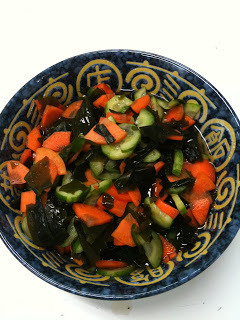 And here you can see the wakame salad in a paper cup on one child's lunch mat. Yum!
And here you can see the wakame salad in a paper cup on one child's lunch mat. Yum!


So there I was, and all was going smoothly with my first presentation on my picture book The Wakame Gatherers. I'd shown my slides of wakame harvesting and demonstrated the sporeling tying, we'd hydrated wakame, and I'd begun the Q&A when I noticed that I could only see half of the face of the child asking a question. I glanced from child to child; every face had a gaping black hole.
I've been getting migraines with auras since I was thirteen. The first time it happened, I thought I was having a stroke. I recall walking through the school gym on my way to the nurse's office, past the boys in their gym shorts all lined up to play basketball and being acutely aware that I could only see half of them.
My auras arrive without warning. First blindness, then the crescent of flashing triangles, then numbness on one side of my body, aphasia in which I cannot process language, and finally if I don't get horizontal fast, a debilitating headache and nausea. If I can sleep immediately, it's all over within an hour or two; if not it can last an entire day. Check out these paintings of migraine art to get a sense of this bizarre condition.
Migraines usually happen in down time, often on Saturdays. In all my years of getting migraines, only two or three times have they hit me during a work task. So I was stunned to look out at the children yesterday and find their little faces half missing.
I managed to get through their questions, and even to read an excerpt from my book (slowly!), but then I had to bail out. Lucky for me that this happened at Nishimachi where the librarian found a cozy sofa on the top floor of the library for me; and there, among all those books climbing to the ceiling, I was able to sleep for an hour.
And after that? I rose and continued with my grade one visits, the schedule just slightly rearranged. Here is the beautiful wakame salad that was made for the children to eat during lunch.
 And here you can see the wakame salad in a paper cup on one child's lunch mat. Yum!
And here you can see the wakame salad in a paper cup on one child's lunch mat. Yum!
Published on November 11, 2010 00:47
November 8, 2010
November--For Me It's Picture Book Idea Month and Poem A Day Chapbook Month
November is full of challenges, the creative kind. Even here in Japan we can hear the thunderous clacking of keys from writers worldwide working on NaNoWriMo (National Novel Writing Month). Some year I would love to participate in all that frenzy, but November is full of frenzy as it is with my university courses in full swing, and since I am midway through a novel draft with an upcoming deadline, this year I'm exempt from even thinking about participating.
But I am taking part in two other challenges: NaPiIdMo (Picture Book Idea Month) organized by Tara Lazar, and Poem a Day Chapbook Challenge led by Robert Lee Brewer. This means that in addition to my novel writing work, I am aiming to write a poem a day this month and generate 30 new picture book ideas.
Some days I cannot manage to even read the poem prompt on the blog let alone write a poem; some days I only jot down ideas for a poem that I will not actually write for many days.; other days I write three poems that I know are all keepers. Picture book ideas, well, I come up with about three a day even when it's not November, so I'm doing pretty well there.
Challenges motivate me to put my barely formed ideas to paper. The results are often surprising. The Poem A Day challenge I participated in last April resulted in at least ten poems that are now ready or nearly ready to send out to magazines. The NaPiBoWriWee (Picture Book Writing Week) that I joined in May 2009 yielded more than seven picture book manuscripts.
Challenges can be created on a small scale as well. One of the writers' groups I belong to periodically holds MiniNaNo months in which we challenge ourselves to meet particular goals and post about our accomplishments.
So, what challenges are you trying this month?
But I am taking part in two other challenges: NaPiIdMo (Picture Book Idea Month) organized by Tara Lazar, and Poem a Day Chapbook Challenge led by Robert Lee Brewer. This means that in addition to my novel writing work, I am aiming to write a poem a day this month and generate 30 new picture book ideas.
Some days I cannot manage to even read the poem prompt on the blog let alone write a poem; some days I only jot down ideas for a poem that I will not actually write for many days.; other days I write three poems that I know are all keepers. Picture book ideas, well, I come up with about three a day even when it's not November, so I'm doing pretty well there.
Challenges motivate me to put my barely formed ideas to paper. The results are often surprising. The Poem A Day challenge I participated in last April resulted in at least ten poems that are now ready or nearly ready to send out to magazines. The NaPiBoWriWee (Picture Book Writing Week) that I joined in May 2009 yielded more than seven picture book manuscripts.
Challenges can be created on a small scale as well. One of the writers' groups I belong to periodically holds MiniNaNo months in which we challenge ourselves to meet particular goals and post about our accomplishments.
So, what challenges are you trying this month?
Published on November 08, 2010 00:03
October 30, 2010
Takamatsu, Shikoku
This week I took a road trip to Shikoku. Nine hours there, nine hours back, with only about 40 hours on the island. We'd planned to stay longer but cut our stay short to beat a typhoon home. Our Shikoku hosts were Cathy Hirano, the amazingly adept translator of the Moribito books, and SCBWI friend and author Suzanne Kamata, so the visit was rich with book talk.
In Takamatsu, we visited the Isamu Noguchi Garden Museum in Mure, a village full of stone workers, with huge slabs and chunks of rock everywhere.
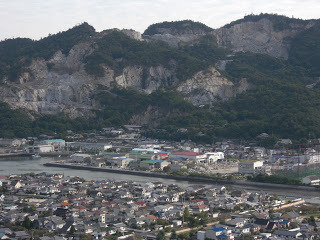 Mure and quarried mountainsIn Mure, Noguchi worked with stone cutter and sculptor Masatoshi Izumi during the seventies and eighties. The day we visited was cool and drizzling rain, making the stone sculptures in every hue especially brilliant and reflective. No photos were allowed so I only have a shot taken from outside the stone circle with the saw-tooth summits of Gokenzan in the background.
Mure and quarried mountainsIn Mure, Noguchi worked with stone cutter and sculptor Masatoshi Izumi during the seventies and eighties. The day we visited was cool and drizzling rain, making the stone sculptures in every hue especially brilliant and reflective. No photos were allowed so I only have a shot taken from outside the stone circle with the saw-tooth summits of Gokenzan in the background.
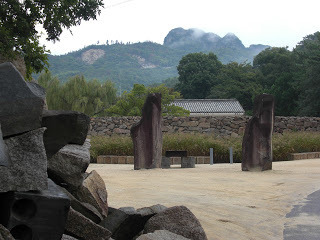 outside the stone circleWe walked about the stone circle where Noguchi worked with Izumi and others in near silence, visited the house Noguchi lived in, and wandered through the kura storehouses that had been converted into his work spaces. How amazing to see his simple tools. And how incredible to have the opportunity to meet Izumi-san, to learn I'd admired his work just several weeks before at the Canadian Embassy in Tokyo where I'd thought of Noguchi without knowing who the embassy roof garden artist was.
outside the stone circleWe walked about the stone circle where Noguchi worked with Izumi and others in near silence, visited the house Noguchi lived in, and wandered through the kura storehouses that had been converted into his work spaces. How amazing to see his simple tools. And how incredible to have the opportunity to meet Izumi-san, to learn I'd admired his work just several weeks before at the Canadian Embassy in Tokyo where I'd thought of Noguchi without knowing who the embassy roof garden artist was.
I was also fortunate to visit the George Nakashima Memorial Gallery, to see his amazing chairs, tables and chests and to have tea and cake at one of his tables.Nakashima is yet another extraordinary artist who crossed cultures in a profound and enduring way.
 bust of George NakashimaWe'd planned to spend another day ferrying to the island of Naoshima to visit museums and art sites, but the typhoon scared me off. Instead we drove up to the temple on Yashima, where tanuki are a big deal...
bust of George NakashimaWe'd planned to spend another day ferrying to the island of Naoshima to visit museums and art sites, but the typhoon scared me off. Instead we drove up to the temple on Yashima, where tanuki are a big deal...
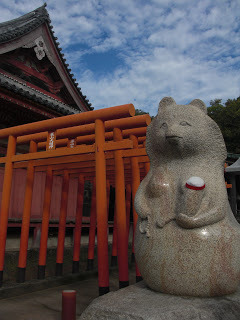 mother tanuki with baby
mother tanuki with baby
and where, being number 84 of the 88 pilgrimage temples, pilgrims come by the busload. We were lucky to arrive at a quiet interval.
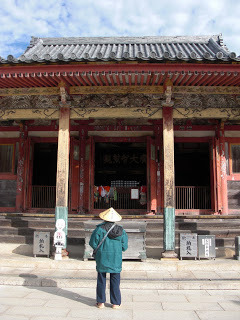 pilgrim visiting the templeFinally we visited Shikoku-mura, an open-air museum with a collection of old preserved Shikoku houses set into a mountain slope: rural family homes, a kabuki theater, merchant houses, round houses where sugar cane was pressed, sheds for steaming mulberry bark for papermaking, buildings where soy sauce and sake were made, and more.
pilgrim visiting the templeFinally we visited Shikoku-mura, an open-air museum with a collection of old preserved Shikoku houses set into a mountain slope: rural family homes, a kabuki theater, merchant houses, round houses where sugar cane was pressed, sheds for steaming mulberry bark for papermaking, buildings where soy sauce and sake were made, and more.
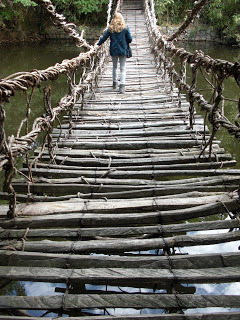 vine bridge entrance to Shikoku-mura
vine bridge entrance to Shikoku-mura soy sauce bottles and jugsThen another 9 hours back in the car...perfect for a long audio book--this trip was The Help by Kathryn Stockett. Kobe, Osaka, Kyoto, Nagoya and Shizuoka zipped by.
soy sauce bottles and jugsThen another 9 hours back in the car...perfect for a long audio book--this trip was The Help by Kathryn Stockett. Kobe, Osaka, Kyoto, Nagoya and Shizuoka zipped by.
In Takamatsu, we visited the Isamu Noguchi Garden Museum in Mure, a village full of stone workers, with huge slabs and chunks of rock everywhere.
 Mure and quarried mountainsIn Mure, Noguchi worked with stone cutter and sculptor Masatoshi Izumi during the seventies and eighties. The day we visited was cool and drizzling rain, making the stone sculptures in every hue especially brilliant and reflective. No photos were allowed so I only have a shot taken from outside the stone circle with the saw-tooth summits of Gokenzan in the background.
Mure and quarried mountainsIn Mure, Noguchi worked with stone cutter and sculptor Masatoshi Izumi during the seventies and eighties. The day we visited was cool and drizzling rain, making the stone sculptures in every hue especially brilliant and reflective. No photos were allowed so I only have a shot taken from outside the stone circle with the saw-tooth summits of Gokenzan in the background. outside the stone circleWe walked about the stone circle where Noguchi worked with Izumi and others in near silence, visited the house Noguchi lived in, and wandered through the kura storehouses that had been converted into his work spaces. How amazing to see his simple tools. And how incredible to have the opportunity to meet Izumi-san, to learn I'd admired his work just several weeks before at the Canadian Embassy in Tokyo where I'd thought of Noguchi without knowing who the embassy roof garden artist was.
outside the stone circleWe walked about the stone circle where Noguchi worked with Izumi and others in near silence, visited the house Noguchi lived in, and wandered through the kura storehouses that had been converted into his work spaces. How amazing to see his simple tools. And how incredible to have the opportunity to meet Izumi-san, to learn I'd admired his work just several weeks before at the Canadian Embassy in Tokyo where I'd thought of Noguchi without knowing who the embassy roof garden artist was.I was also fortunate to visit the George Nakashima Memorial Gallery, to see his amazing chairs, tables and chests and to have tea and cake at one of his tables.Nakashima is yet another extraordinary artist who crossed cultures in a profound and enduring way.
 bust of George NakashimaWe'd planned to spend another day ferrying to the island of Naoshima to visit museums and art sites, but the typhoon scared me off. Instead we drove up to the temple on Yashima, where tanuki are a big deal...
bust of George NakashimaWe'd planned to spend another day ferrying to the island of Naoshima to visit museums and art sites, but the typhoon scared me off. Instead we drove up to the temple on Yashima, where tanuki are a big deal...  mother tanuki with baby
mother tanuki with babyand where, being number 84 of the 88 pilgrimage temples, pilgrims come by the busload. We were lucky to arrive at a quiet interval.
 pilgrim visiting the templeFinally we visited Shikoku-mura, an open-air museum with a collection of old preserved Shikoku houses set into a mountain slope: rural family homes, a kabuki theater, merchant houses, round houses where sugar cane was pressed, sheds for steaming mulberry bark for papermaking, buildings where soy sauce and sake were made, and more.
pilgrim visiting the templeFinally we visited Shikoku-mura, an open-air museum with a collection of old preserved Shikoku houses set into a mountain slope: rural family homes, a kabuki theater, merchant houses, round houses where sugar cane was pressed, sheds for steaming mulberry bark for papermaking, buildings where soy sauce and sake were made, and more. vine bridge entrance to Shikoku-mura
vine bridge entrance to Shikoku-mura soy sauce bottles and jugsThen another 9 hours back in the car...perfect for a long audio book--this trip was The Help by Kathryn Stockett. Kobe, Osaka, Kyoto, Nagoya and Shizuoka zipped by.
soy sauce bottles and jugsThen another 9 hours back in the car...perfect for a long audio book--this trip was The Help by Kathryn Stockett. Kobe, Osaka, Kyoto, Nagoya and Shizuoka zipped by.
Published on October 30, 2010 06:59
October 11, 2010
Japan Writers Conference 2010
This long weekend was the Fourth Annual Japan Writers Conference (JWC). The event kicked off with a dinner at the Pink Cow restaurant in Shibuya on Saturday night with readings of poetry and prose written by others. Conference sessions were then held Sunday and Monday at the Nihon University College of Art in Ekoda, Tokyo.
On Sunday I attended a poetry workshop led by poet David Gilbey visiting from Australia; "Telling the True Story" by author Margi Preus; David Chester's "How to Write a Screenplay You Can Sell"; and a reading by poet Leza Lowitz with shakuhachi performance by Christopher Yohmei Blasdel, and I gave my own presentation "Of Power and Emotions: Writing Fiction for Young Adults." Saturday evening's dinner was at the nearby restaurant Peace. On Monday I attended Daily Yomiuri writer Tom Baker's session "Interviewing Creative Subjects"; John Paul Catton's session on using Japanese mythology in fiction; Gregory Dunne's session on the Haibun form; and Marian Pierce's tale of how she broke into print. There were many concurrent sessions I would have also loved to attend.
I took away plenty of practical tidbits and loads of inspiration. It is always motivating to be in the company of accomplished writers of many different genres. Over the three days, among other things, I came up with another YA novel idea, plans for several poems, and a solution to developing one of my short stories. I also learned a structural plotting technique I'd like to apply to my current work-in-progress.
Thanks to organizers John Gribble, Bern Mulvey and Karen McGee for all their hard work. The conference, free of charge, is a real gift. I look forward to hearing the details of 2011 JWC. Below are a few photos of JWC 2010.
Nihon University College of Art, Ekoda
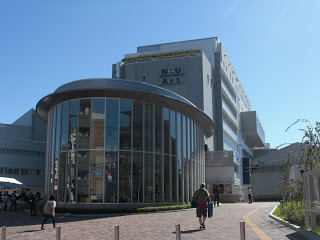
Participants with, in the center, two JWC organizers--John Gribble and Karen McGee
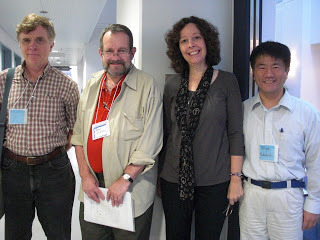
A few of the SCBWI members in attendance--Suzanne Kamata, Colleen Sakurai, Margi Preus and me
Rolling dice to create stories with Japanese mythology elements in John Paul Catton's session
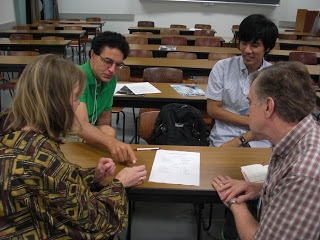
The Daily Yomiuri's Tom Baker on conducting interviews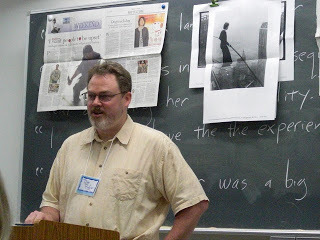

On Sunday I attended a poetry workshop led by poet David Gilbey visiting from Australia; "Telling the True Story" by author Margi Preus; David Chester's "How to Write a Screenplay You Can Sell"; and a reading by poet Leza Lowitz with shakuhachi performance by Christopher Yohmei Blasdel, and I gave my own presentation "Of Power and Emotions: Writing Fiction for Young Adults." Saturday evening's dinner was at the nearby restaurant Peace. On Monday I attended Daily Yomiuri writer Tom Baker's session "Interviewing Creative Subjects"; John Paul Catton's session on using Japanese mythology in fiction; Gregory Dunne's session on the Haibun form; and Marian Pierce's tale of how she broke into print. There were many concurrent sessions I would have also loved to attend.
I took away plenty of practical tidbits and loads of inspiration. It is always motivating to be in the company of accomplished writers of many different genres. Over the three days, among other things, I came up with another YA novel idea, plans for several poems, and a solution to developing one of my short stories. I also learned a structural plotting technique I'd like to apply to my current work-in-progress.
Thanks to organizers John Gribble, Bern Mulvey and Karen McGee for all their hard work. The conference, free of charge, is a real gift. I look forward to hearing the details of 2011 JWC. Below are a few photos of JWC 2010.
Nihon University College of Art, Ekoda

Participants with, in the center, two JWC organizers--John Gribble and Karen McGee

A few of the SCBWI members in attendance--Suzanne Kamata, Colleen Sakurai, Margi Preus and me

Rolling dice to create stories with Japanese mythology elements in John Paul Catton's session

The Daily Yomiuri's Tom Baker on conducting interviews

Published on October 11, 2010 20:45



